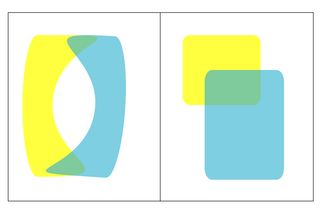In mathematics, a Leray cover(ing) is a cover of a topological space which allows for easy calculation of its cohomology. Such covers are named after Jean Leray.

Mathematics includes the study of such topics as quantity, structure, space, and change.
In mathematics, a cover of a set is a collection of sets whose union contains as a subset. Formally, if
In topology and related branches of mathematics, a topological space may be defined as a set of points, along with a set of neighbourhoods for each point, satisfying a set of axioms relating points and neighbourhoods. The definition of a topological space relies only upon set theory and is the most general notion of a mathematical space that allows for the definition of concepts such as continuity, connectedness, and convergence. Other spaces, such as manifolds and metric spaces, are specializations of topological spaces with extra structures or constraints. Being so general, topological spaces are a central unifying notion and appear in virtually every branch of modern mathematics. The branch of mathematics that studies topological spaces in their own right is called point-set topology or general topology.
Sheaf cohomology measures the extent to which a locally exact sequence on a fixed topological space, for instance the de Rham sequence, fails to be globally exact. Its definition, using derived functors, is reasonably natural, if technical. Moreover, important properties, such as the existence of a long exact sequence in cohomology corresponding to any short exact sequence of sheaves, follow directly from the definition. However, it is virtually impossible to calculate from the definition. On the other hand, Čech cohomology with respect to an open cover is well-suited to calculation, but of limited usefulness because it depends on the open cover chosen, not only on the sheaves and the space. By taking a direct limit of Čech cohomology over arbitrarily fine covers, we obtain a Čech cohomology theory that does not depend on the open cover chosen. In reasonable circumstances (for instance, if the topological space is paracompact), the derived-functor cohomology agrees with this Čech cohomology obtained by direct limits. However, like the derived functor cohomology, this cover-independent Čech cohomology is virtually impossible to calculate from the definition. The Leray condition on an open cover ensures that the cover in question is already "fine enough." The derived functor cohomology agrees with the Čech cohomology with respect to any Leray cover.
In mathematics, sheaf cohomology is the application of homological algebra to analyze the global sections of a sheaf on a topological space. Broadly speaking, sheaf cohomology describes the obstructions to solving a geometric problem globally when it can be solved locally. The central figure of this study is Alexander Grothendieck and his 1957 Tohuku paper.

In mathematics, de Rham cohomology is a tool belonging both to algebraic topology and to differential topology, capable of expressing basic topological information about smooth manifolds in a form particularly adapted to computation and the concrete representation of cohomology classes. It is a cohomology theory based on the existence of differential forms with prescribed properties.
In mathematics, certain functors may be derived to obtain other functors closely related to the original ones. This operation, while fairly abstract, unifies a number of constructions throughout mathematics.
Let be an open cover of the topological space , and a sheaf on X. We say that is a Leray cover with respect to if, for every nonempty finite set of indices, and for all , we have that , in the derived functor cohomology. [1] For example, if is a separated scheme, and is quasicoherent, then any cover of by open affine subschemes is a Leray cover. [2]







